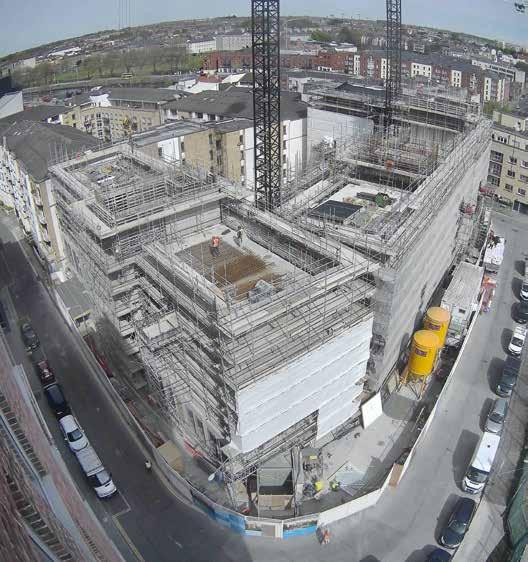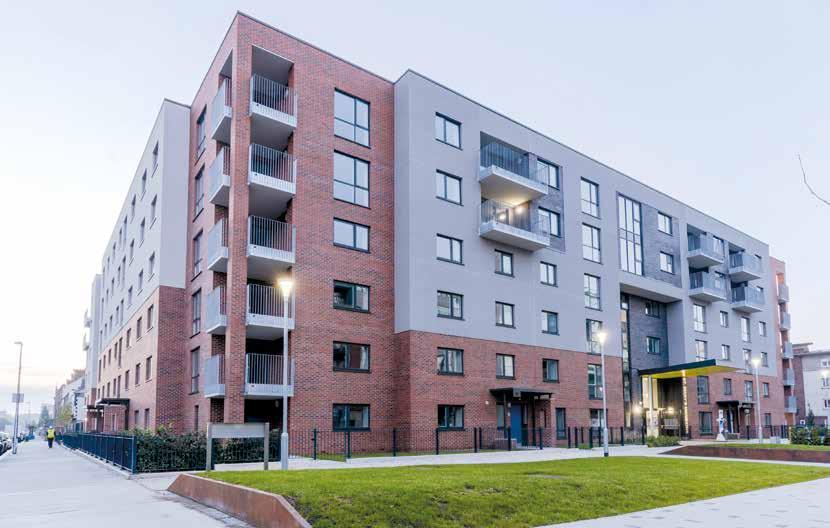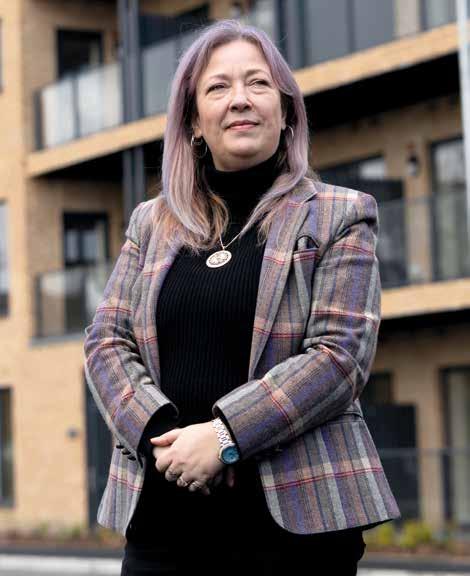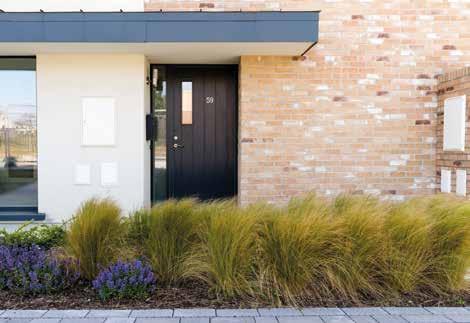
13 minute read
Quintain, Vision Contracting, Clancy ‘The Sisk Living business model is different to that of a traditional builder
FERGAL LALOR, Managing Director, Sisk Living, speaks with Barry McCall about current factors affecting the house-building market and why the Sisk Living business model ideally places it to deliver social and affordable homes.
Advertisement
Fergal Lalor, Managing Director, Sisk Living. S isk is one of the best-known names in Irish residential construction. The Sisk company has been building homes and communities for the past five decades, and up until the Covid pandemic, it has been completing some 1,500 residential units every year and making a significant contribution to the state’s social and affordable housing targets in the process. Sisk established Sisk Living over four years ago to focus on low-rise residential projects.
“We have a strong bias towards social and affordable housing,” says Sisk Living managing director Fergal Lalor. “We are a contract builder, and we do not expose ourselves to development risk. Our clients are in the main approved housing bodies, local authorities or private-sector providers of social and affordable housing, or private rental sector (PRS). As a contract builder, we are focused on delivering at scale and speed for those clients.”
SISK LIVING BUSINESS MODEL “The Sisk Living business model is different to that of a traditional builder-developer,” he explains. “Many companies who self-develop deliver at the pace of market absorption,” Lalor explains. “They will build 20 units at a time or whatever suits. We go in and deliver a scheme at scale, whether that’s 80, 100 or 200 units at a time. We are focused on clients who like that approach. That typically suits local authorities, approved housing bodies, private-sector providers and so on. Once the decision is made to move ahead with a development following the design and planning process and other preparatory elements, they want delivery now. It suits our business model to do that.”
The pipeline of social and affordable housing is improving at present, with greater visibility into the future as well.
“We can see almost 3,000 units in the procurement pipeline at the moment, which we haven’t seen in the past, but as the plan is to build up to 9,000 social and affordable units this year, we still have a way to go,” says Lalor.
“There are a variety of projects being brought to the market, such as the Killinarden and Old White Church Road schemes by South Dublin County Council and Cork City Council, respectively, where the developer of the social, affordable and some cases the private scheme are brought to planning by the economic operator on a licence on state lands,” he adds. “The challenge for a contract builder like ourselves is that when you are waiting for the proverbial bus, they all come along at once.”
HOUSING MARKET TRENDS There are positive trends in the market as well, with the introduction of a greater mix of tenure types to developments.
“We are seeing a good mix of social, affordable, private, and cost rental,” he notes. “From a planning point of view, it is very important for developments to be tenure blind. You shouldn’t be able to distinguish one type from another. The architecture, materials and layout have to be similar throughout. And we are seeing significant effort going into mixing tenure types.”
And it’s not just a question of numbers.
“You don’t want to end up with one part of a development being exclusively social or private; you want to remove any stigma associated with any tenure type. That’s what we are seeing from a planning point of view now.”
There has also been a move to a healthy mix of housing typologies. Fergal Lalor says Sisk Living is seeing a good mix of threebed semis, duplexes, low-rise and mid-rise housing.
“In social housing, there is a very concerted effort towards own door access, where you have buildings two, three and four storeys high. Instead of a management company operating lifts and so on, the residents can look after those things themselves.”
The company currently has over 450 units under construction.
“We had a number of live projects prior to the latest shutdown, and we were pleased to see all of our sites open in April. We see industry challenges with both labour and material supply. However, none of these are particularly surprising, and we have been planning our way through dealing with them.”
MODERN METHODS OF CONSTRUCTION Sisk Living is a strong advocate of modern methods of construction (MMC).
“MMC brings much greater speed and efficiency to home building,” says Lalor. “Using offsite fabrication light-gauge steel
panels with our strategic partner Vision Built in Galway, we can develop a scheme in west Dublin while providing employment in Oranmore. It’s very good for balanced regional development.
“We use a variety of structural forms best suited to the typology of the site,” he continues. “For housing, we use light-gauge steel, insulated concrete formwork (ICF) and timber frame. For duplexes and lowrise apartments, we would predominantly use light gauge steel from Vision Built. The benefits of offsite fabrication are significant to the scale and delivery of the projects that we have and expect to tender for going forward.”
Though MMC comes with constraints.
“Currently, public and private sector schemes can have a myriad of housing typologies. They can have four variants of three-bed and five variants of four-bed houses. That lowers the efficiency of offsite construction, which is at its best when house types are limited. Offsite construction has to be accommodated at the planning stage. There is no point in designing 15 types of homes and expecting MMC to deliver rapid build.”
BIM BENEFITS BIM Level 3 is also vital, as it offers the precision required by offsite fabrication. But it requires a design freeze at a particular stage so that there are no further amendments.
“This allows for the offsite manufacturing to be done once the design reaches a certain point. If you go to a window or door manufacturer at the moment, they won’t make anything until they have measured on site. Traditional methods of construction have variations, but MMC precision is so high, you can place the order directly off the designs. The panacea is to do as much in the factory as possible. Ultimately, we will move to panels with the windows and doors already in them.”
DELIVERING SOCIAL HOUSING There are other issues at play when it comes to the delivery of social and affordable housing, according to Fergal Lalor.
“One of the biggest challenges to the codevelopment of different tenure types is with how the land is brought to the market. We can see several different models in play at the moment.”
The first involves bringing local authority lands through a public procurement process, typically with the benefit of a masterplan and a tenure mix specification and seeking for the economic operator to develop a tenureblind mix.
“The challenge here is in bringing to market an affordable scheme that is typically 10% less than the market value,” he explains. “The factors affecting this are the cost of the land set by the local authority and the site services fund. In addition, the market awaits the delivery of shared equity schemes, and some cost rental are coming on line this year.”

LAND DEVELOPMENT AGENCY Then there is the Land Development Agency (LDA).
“The LDA is typically developing state lands outside of local authority ownership, and these afford an even wider range of tenure mixes, which will attract combinations of approved housing bodies, individual owners and institutional investors. Approved housing bodies, including those specialising in affordable housing, will remain the largest deliverer of schemes.”
PROCUREMENT CHALLENGE Procurement will remain the single biggest challenge, he believes.
“In full acceptance that the public bodies must remain compliant, there are a variety of ways in which the timelines can be improved. Current local-authority developed schemes can take up to 33 months to deliver. This can be improved by 20% improvement to 27 months by running planning and procurement in parallel and improving construction delivery through maximising offsite fabrication and limiting the number of residential typologies on and one site.”
He argues that a more aggressive overlap can achieve further improvements with planning, such that by the end of the local authority Part 8 process a preferred tenderer is selected.
“Along with the construction improvement, overlapping could bring the delivery period down to 22 months or a 35% improvement.”
And there are other benefits to be gained from early procurement.
“It would support the sustainability agenda by locking in more energy-efficient homes through planning for them at an early stage. It would provide mitigation to rising costs by involving the contract builder earlier to help come up with the most buildable and cost-effective solution, and it would offer an economic boost required for the industry and the overall economy post-Covid.”
ATTRACTING NEW TALENT Finally, Fergal Lalor points out that the industry will need to attract a lot of talent back along with new people if it is to deliver on the government’s housing targets.
“The industry built 20,000 houses last year, but the target is 35,000 a year. We need to attract people back to the industry and get new people to choose it for their careers. But the challenge is getting someone to enter into training or retraining for four or five years to work in an industry that experiences peaks and troughs. The government needs to stay the course in terms of putting capital investment into residential over the coming years,” he concludes.
Bonham Street, Dublin, development for Dublin City Council.

St Mary’s Mansion’s, a €23m redevelopment by Clúid Housing in Dublin’s north east inner city.
Keeping it social

FIONA CORMICAN, New Business Director, Clúid Housing, speaks with Barry McCall about how the social housing delivery model has changed in recent years and calls for more joined-up thinking between stakeholders around building social housing.
Despite the Covid lockdowns, Clúid Housing has continued to make a significant contribution to the government’s social housing target.
With a pipeline of 3,000 homes, Clúid Housing is one of Ireland’s largest approved housing bodies (AHBs). Founded in 1994, the organisation now has over 8,300 properties under management. Clúid focuses on delivering social housing solutions to those on local authority housing lists.
Fiona Cormican, New Business Director, Clúid Housing, says that the body is committed to providing quality housing and services that enable people to create homes and thriving communities. “There are 12 or 13 large AHBs in Ireland, and Clúid is one of the largest. We deliver a lot of new builds. In fact, 96% of our pipeline is new build, so we are increasing supply all of the time.”
CLÚID HOUSING MODEL Clúid built 675 homes last year, despite Covid, and it has another 3,000 in the pipeline to be delivered in 2021 and 2022.
“We built 800 in 2019 and aim to build 1,000 this year, depending on lockdowns,” Cormican adds. “We have a robust pipeline for the next few years.”
Clúid’s residents are people who were on housing lists.
“We work in partnership with local authorities to provide social housing for people on their housing lists.”
The rental model can vary according to the resident’s means and includes cost rental. Allocation is decided by the local authority for social housing or the AHB involved for cost rental. In some cases where demand is high, a lottery can be run as long as all the people entered to qualify for the cost rental scheme.
The Clúid model is somewhat different to many of the other approved housing bodies (AHBs).
“We are focused on owning our properties,” Cormican explains. “There is an awful lot more involved in owning the homes than leasing them for a period of time. We are focused on quality. The lifetime cost and value of the homes and their carbon footprint are very important to us. We also have a big focus on creating sustainable communities where people can be proud to live.”
The long term view is critical in light of Clúid’s financial model.
FINANCING SOCIAL HOUSING “In 2011, we saw a real change in how AHBs are financed,” she points out. “Capital grants from the state were phased out, and debt finance was phased in. We had a lot of learning to do in a short space of time, but the AHBs managed to do this very well.”
That new arrangement sees the government back Clúid and other AHBs with ‘soft’ 30-year loans to meet 30% of their capital expenditure needs. The AHBs raised the balance on the private credit markets. The government support has the effect of de-risking the private debt finance and enables the organisations to negotiate more favourable terms.
That model brings certain pressures with it.
“When you are using debt finance, you don’t want voids. You want to build places where people want to live. Our focus is on neighbourhoods and communities, not just houses. Our residents’ voice is also very important to us. We listen to residents on what they want from their homes and communities, and we do our best to respond quickly.”
That requires a thoughtful approach.
“We try to make the best use of land. We put foundations in place that are built to last and mature. We try to future proof all of our developments and promote active and healthy lifestyles within them. Nearly zero-energy buildings (NZEB) has been our policy for the past four or five years. This is part of promoting better lives.”
Those policies bring a degree of personal satisfaction.
“These policies make Clúid Housing a great place to work. It’s also a fascinating place to work. We are constantly thinking about people, not profit. That doesn’t mean that we don’t focus on value for money. It’s all about securing the best price and providing houses in the best locations possible. We are a non-profit organisation, but we operate in a commercially viable and sustainable way, which will allow us to continue providing good quality housing and services for generations to come.”

WORKING WITH DEVELOPERS AND BUILDERS In so far as is possible, Clúid develops its own schemes. However, there are occasions when the organisation will purchase from developers.
“We try to achieve a balance between the two. We develop a lot of houses, and we are a big player in the market,” says Cormican. “What we do has a huge impact.”
Clúid introduced an attractive proposition for small to mid-sized developers in 2017. It sees Clúid purchase a development and pay staged payments during construction.
“We will do this if we like what they are building,” she says. “It gives us control of quality on site, and it’s great for the developers as they don’t have to finance the development while it’s on site.”
Clúid will typically work with smaller organisations that are building 20 to 40 houses at a time, but it also works with larger developers on large mixed-tenure schemes.
Fiona Cormican explains: “Working with smaller organisations helps create local employment, as those builders are buying from local suppliers. Building for us allows them to free up resources to build new houses for the private market. So, we are not only delivering social housing but helping the private market as well.”

A COLLABORATIVE APPROACH Looking to the future, Fiona Cormican believes there several measures that could smooth the delivery of social and affordable housing.
“More collaboration is always the way forward,” she says. “A lot of stakeholders are involved in the social housing process, and a more structured framework for collaboration would be very helpful,” she concludes.
Fiona Cormican, New Business Director, Clúid Housing.











